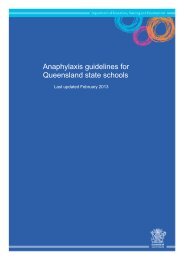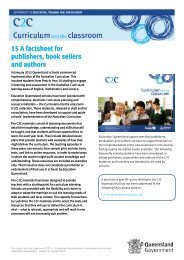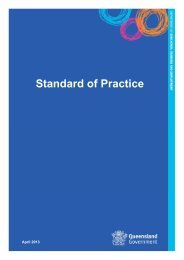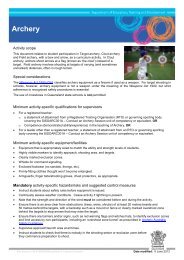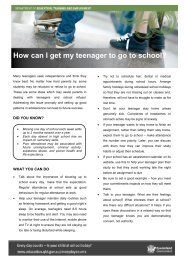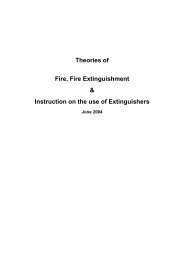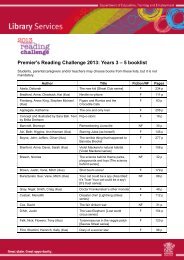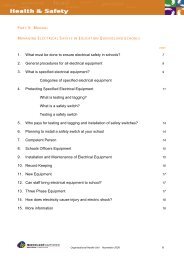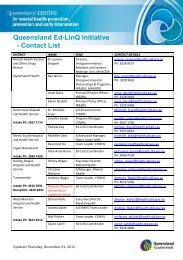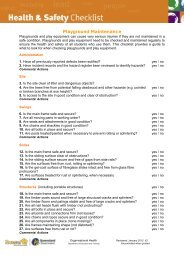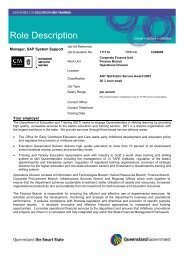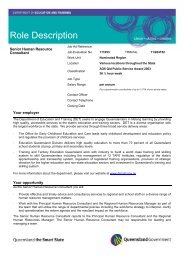Smart Choices - Healthy Food and Drink Supply Strategy for ...
Smart Choices - Healthy Food and Drink Supply Strategy for ...
Smart Choices - Healthy Food and Drink Supply Strategy for ...
You also want an ePaper? Increase the reach of your titles
YUMPU automatically turns print PDFs into web optimized ePapers that Google loves.
<strong>Food</strong> safety<br />
The Australian Dietary Guidelines now include<br />
a guideline about food safety in recognition of<br />
the importance of being vigilant when preparing<br />
<strong>and</strong> serving food. Schools, including the<br />
tuckshop, have a responsibility to maintain safe<br />
food-h<strong>and</strong>ling practices <strong>and</strong> high st<strong>and</strong>ards<br />
of hygiene. This is essential to avoid food<br />
poisoning <strong>and</strong> ensure students have access to<br />
high-quality, safe <strong>and</strong> suitable food.<br />
Many resources are available to assist in<br />
meeting safe food-h<strong>and</strong>ling requirements <strong>and</strong><br />
are listed on pages 24–25.<br />
The Australian Guide to <strong>Healthy</strong> Eating<br />
The Australian Guide to <strong>Healthy</strong> Eating provides<br />
in<strong>for</strong>mation about the amounts <strong>and</strong> kinds of<br />
food we need each day from the five basic food<br />
groups to obtain sufficient nutrients <strong>for</strong> good<br />
health <strong>and</strong> wellbeing <strong>and</strong> is consistent with the<br />
Australian Dietary Guidelines.<br />
The Australian Guide to <strong>Healthy</strong> Eating, Commonwealth<br />
Copyright 1998, is reproduced with permission of the Australian<br />
Government Department of Health <strong>and</strong> Ageing, 2005.<br />
The basic five food groups<br />
While the Australian Dietary Guidelines<br />
provide the general framework <strong>for</strong> how <strong>and</strong><br />
what should be eaten, the AGTHE provides<br />
more specific advice regarding the number of<br />
serves needed from each of the basic five food<br />
groups.<br />
The AGTHE uses a plate model, divided into<br />
different sized segments, to indicate the<br />
proportions of food from each of the five food<br />
groups that we should be eating <strong>for</strong> good<br />
health. <strong>Food</strong>s are grouped together because<br />
they share a similar range of nutrients. Over<br />
three-quarters of food intake should come from<br />
three major food groups – the breads, cereals,<br />
rice, pasta <strong>and</strong> noodles group, the vegetables<br />
<strong>and</strong> legumes group, <strong>and</strong> the fruit group.<br />
Extra foods<br />
Some foods do not fit into the five food groups<br />
because they are not essential to provide the<br />
nutrients needed. They are regarded as ‘extra’<br />
foods <strong>and</strong> include biscuits, cakes, desserts,<br />
pastries, soft drinks, high-fat snack items such<br />
as crisps, pies, pasties, sausage rolls <strong>and</strong> other<br />
takeaways, lollies <strong>and</strong> chocolates.<br />
Most of these foods are high in fat (particularly<br />
saturated fat), <strong>and</strong>/or salt <strong>and</strong>/or added sugar<br />
<strong>and</strong> <strong>for</strong> these reasons it is recommended their<br />
intake is limited. When eaten only occasionally<br />
or in small serves they can add variety to the<br />
diet without replacing the healthier foods<br />
needed each day.<br />
How many serves?<br />
The number of serves of different foods<br />
children <strong>and</strong> young people should eat on<br />
average each day depends on an individual’s<br />
body size <strong>and</strong> activity level.<br />
The table below provides a guide to the<br />
number of serves of each of the five food<br />
groups that children <strong>and</strong> young people should<br />
aim to eat each day. Very active children <strong>and</strong><br />
young people may need more each day than<br />
shown in the table.<br />
Children can consume up to one-third of their<br />
daily nutritional intake at school. As many<br />
children regularly purchase food from school<br />
tuckshops, it is important that tuckshops<br />
provide a wide variety of foods from the five<br />
food groups <strong>and</strong> promote <strong>and</strong> model healthy<br />
food choices.<br />
What is a serve?<br />
Recommended number of daily serves <strong>for</strong> children <strong>and</strong> young people<br />
Example serves in the table on the following<br />
page define the amount of food that equals<br />
one serve within each food group. For example,<br />
two slices of bread or one medium bread roll is<br />
equivalent to one serve. Read the table below<br />
in conjunction with the table on the following<br />
page to work out how much food from each<br />
food group to aim <strong>for</strong> each day.<br />
4–7 Years 8–11 Years 12–18 Years<br />
Cereals (including breads, rice, pasta, noodles) 5–7 6–9 5–11<br />
Vegetables, legumes 2 3 4<br />
Fruit 1 1 3<br />
Milk, yoghurt, cheese 2 2 3<br />
Lean meat, fish, poultry, nuts <strong>and</strong> legumes 1/2 1 1<br />
Extra foods (have no more than) 1–2 1–2 1–3<br />
Source: The Australian Guide to <strong>Healthy</strong> Eating, Commonwealth Department of Health <strong>and</strong> Family Services, 1998.<br />
4 5



